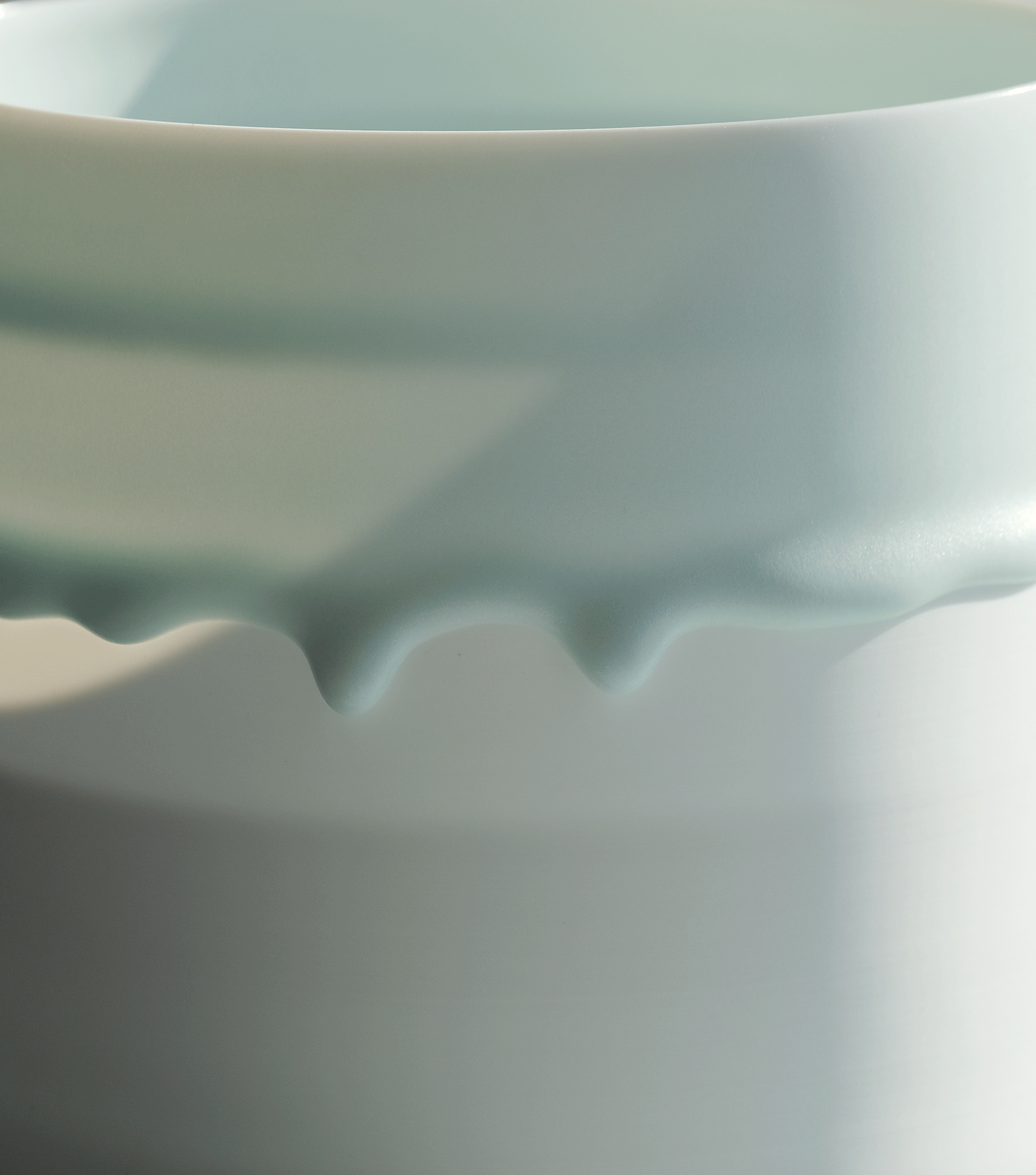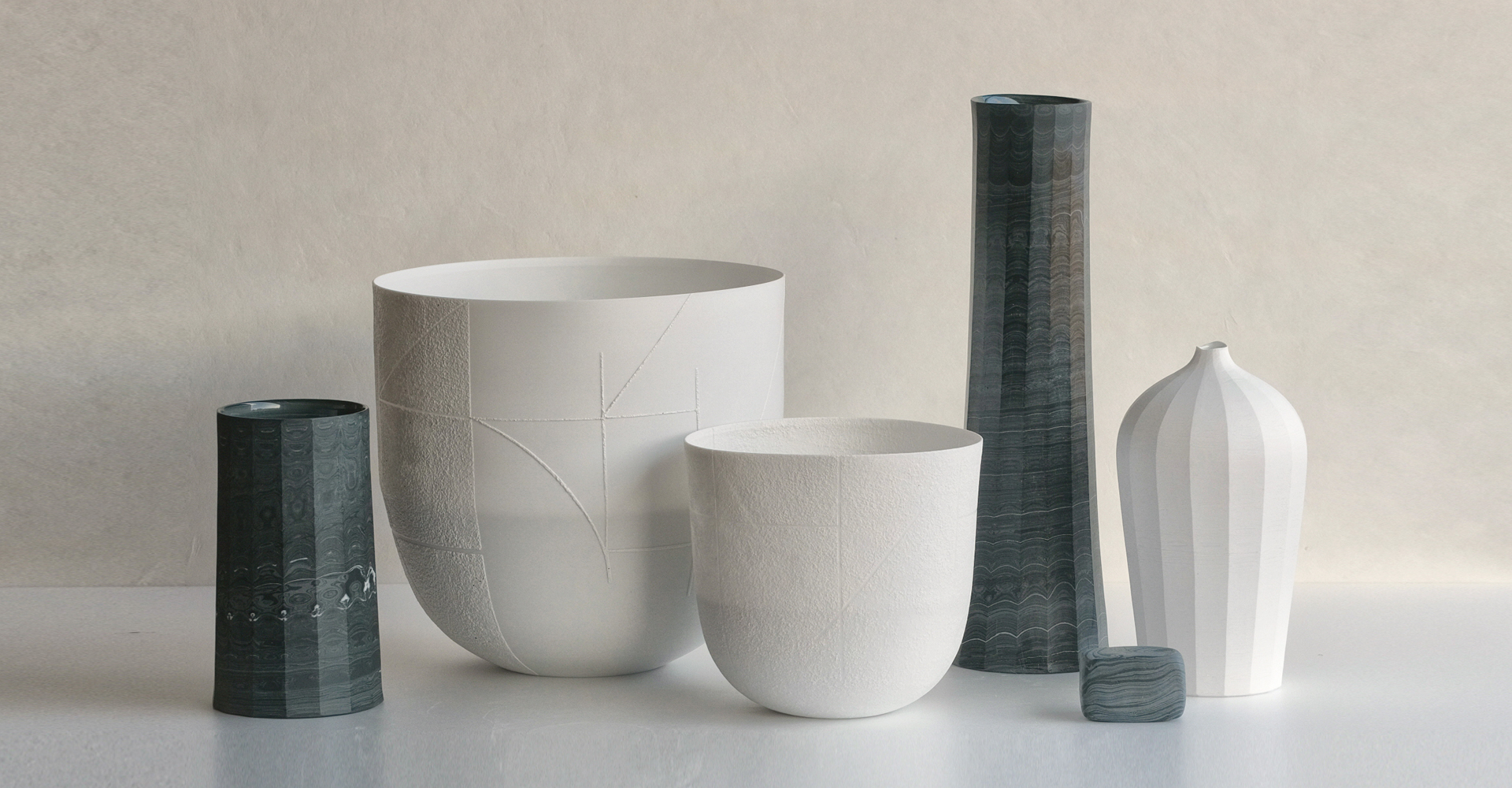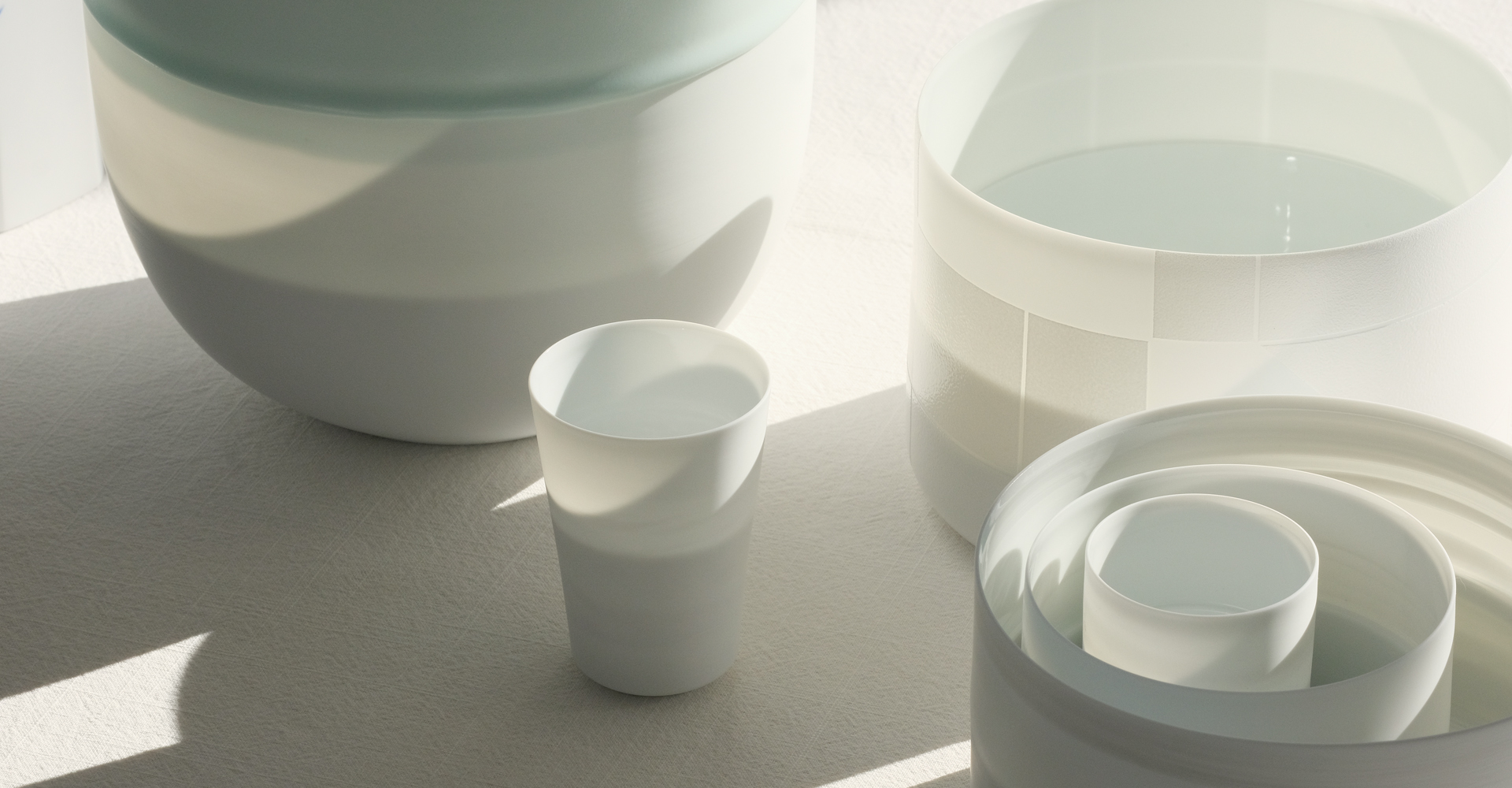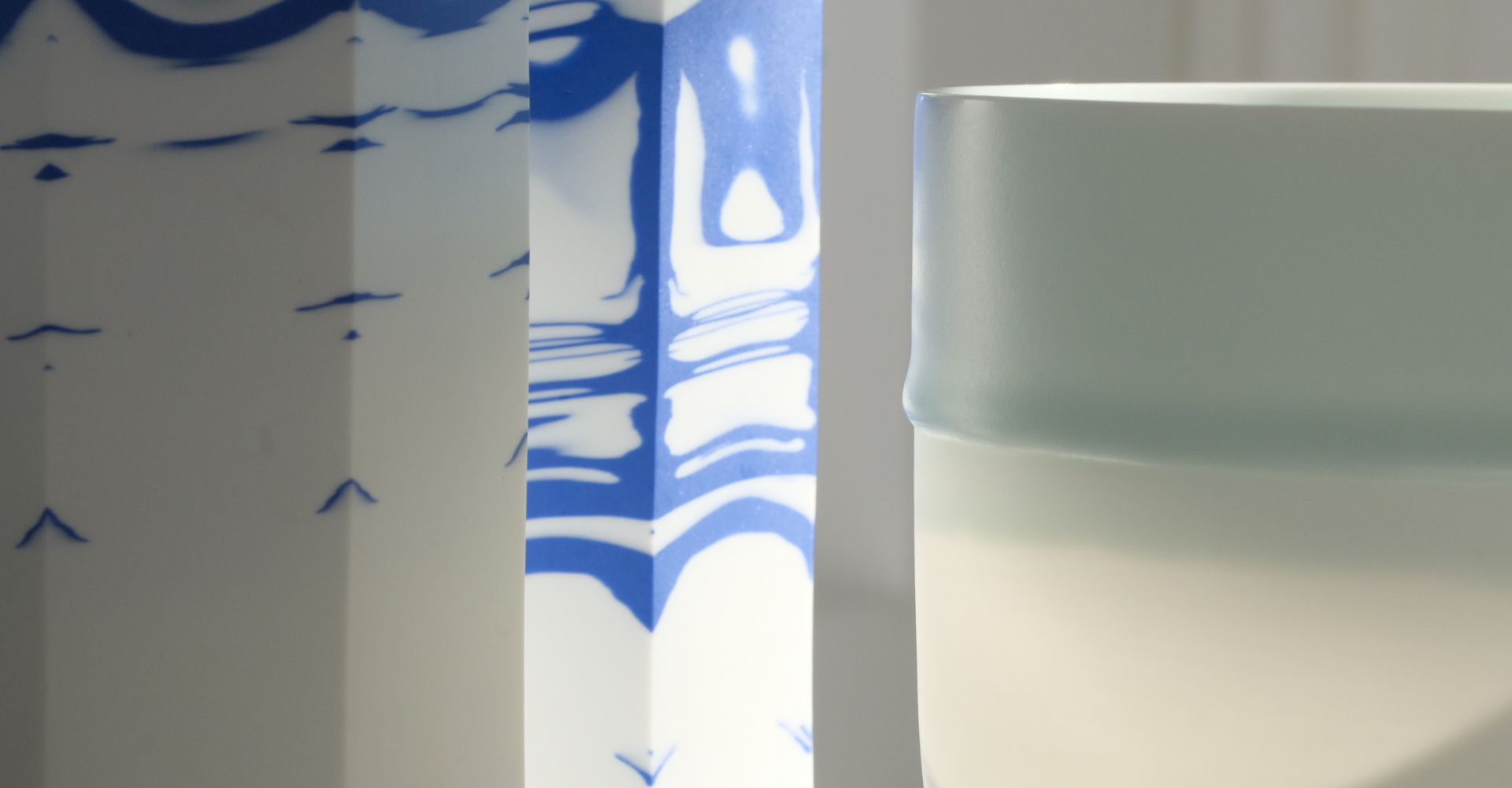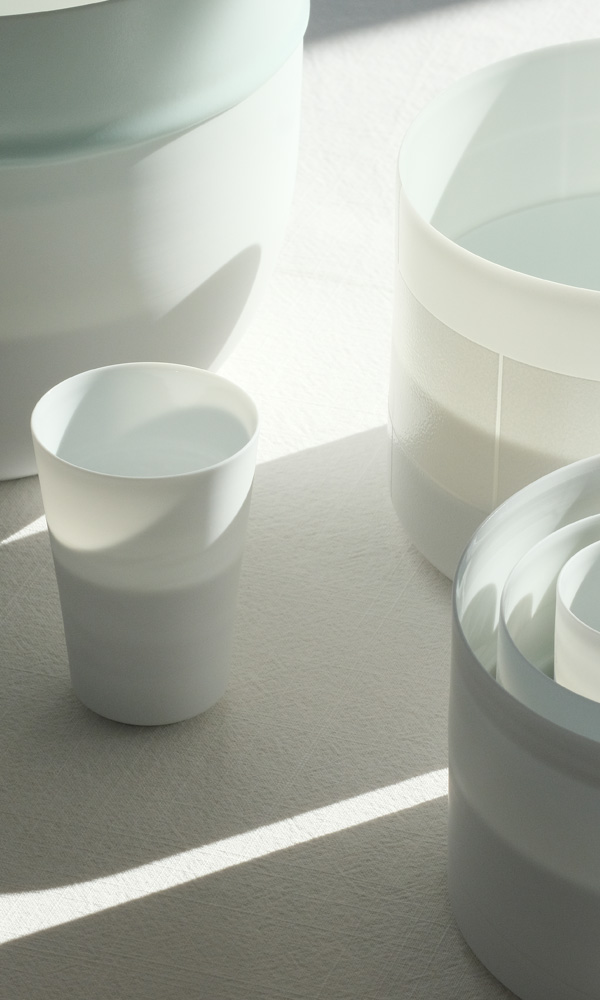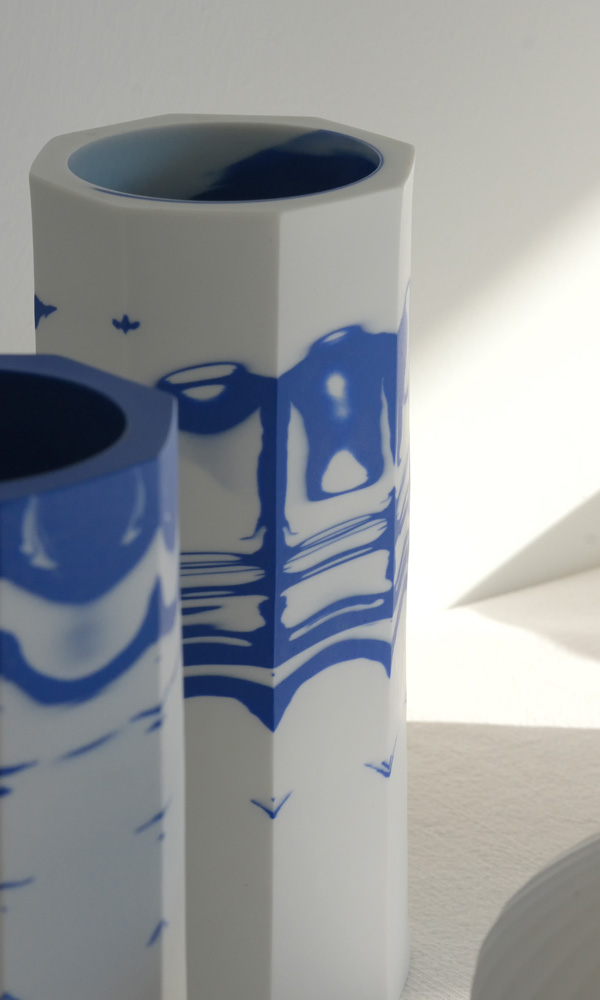Material, Moments_2019년 개인전
현재에서 과거로 거슬러 올라가 살펴보면 강원도 양구의 방산 사람들의 삶 한가운데에 양구백토, 양구백자가 있었다. 고온에서 번조되어 아름다운 빛깔과 강도를 갖는 양구백토가 방산면 일대에 다량 매장되어 있었고, 조선왕조 400여 년간 방산의 사람들은 육로와 수로를 이용하여 경기도 광주 분원에 이를 공납하였다. 고려 말기부터 방산에 도자기 제작소가 생겨났고, 가마의 불길은 근대까지 타올랐다. 아직까지도 마을 어른들의 기억 속에는 산자락 어귀의 도자기 제작소가 아련하게 남아있다. 이곳에 10여 년 전 양구백자박물관이 지어졌고 나와 남편, 김덕호 작가는 2013년에 설립된 서울대학교 양구백자연구소에서 양구백토를 연구하고 있다.
조선백자의 역사와 아름다움이 이어질 수 있었던 것은 원재료인 양구백토가 있었기 때문이라 하여도 과언이 아니다. 오래전부터 존재해오던 양구백토를 누군가 어느 날, 어느 순간에 발견하여 이 모든 것이 결정되었다는 것은 참으로 경이롭다. 그와 동시에 이 부드러운 백색의 점토가 단단한 광석으로부터 비롯된다는 사실은 눈으로 직접 확인하여도 생소하다. 양구에 오기 전까지 가공된 모습으로 곱게 포장되어 작업실 문 앞까지 배송되는 백자토를 사용하였다, 재료의 원래 모습은 책으로 읽어 이해한 것이 다였으니 양구백토를 처음 보았을 때의 낯설음은 이루 말할 수 없었다. 옛 방산의 사람들은 사방을 둘러 싼 산과 천변川邊을 해매이며 발견한 백색의 광맥에서 조심스레 원토를 채굴하여 백색의 덩어리들을 수집하였다. 산처럼 쌓아놓은 귀중한 백색의 덩어리에 수 천, 수 만 번의 손길을 더하여 불순물을 긁어냈고 이를 방아로 잘게 부수어 고운 입자로 만든 뒤 맑은 수입천의 물로 점토만을 걸러냈다. 과거에 백토를 가공했던 과정을 몇 문장으로 풀어서 설명하는 것은 참으로 쉬운 일이다. 그러나 문장의 행간에는 광석을 백토로 가공하기 위한 무수한 시간적, 기술적 층위가 숨겨져 있다. 지표 아래에 존재하는 백토의 광맥이 지천의 어느 곳에 있는지 적절히 유추해야 할 것이며, 그저 하얀 돌이 아닌 백토인지를 적절히 판단할 수 있어야 할 것이다. 부수어진 백토의 입자들을 골라낼 수 있는 수조의 적절한 높이가 있을 것이며, 고운 입자들만을 골라낼 수 있는 적절한 입도의 체를 만들어야 할 것이고, 적절히 숙성시켜 작업에 알맞은 습도를 가지게 하여야 할 것이다. ‘적절’이라는 말로 생략되어 버리는 무수한 시간과 기술적 층위를 사람들이 알아차리기란 쉽지 않다. 그럼에도 양구백토가 무수한 시간과 기술의 순간들을 거쳐 나의 두 손 안에 있고, 나를 통해 새로운 가능성을 갖게 된다는 것은 가슴 벅찬 일이다.
나는 무수한 결정의 순간을 거쳐 백토라는 재료로 거듭난 물질을 다룬다. 이 물질은 내 손을 거치기 전에 이미 아름다움을 내포하고 있다. 그렇기에 이것을 대하는 나의 태도는 매우 조심스럽고 신중하다. 이 물질을 다루는 나의 기술과 선택에 따라 이미 간직하고 있는 아름다움이 사라질 수도 있기 때문이다. 그래서 오랜 동안 매일을 연습하고 훈련하며 스스로를 다그쳤다. 백토에 담긴 무수한 시간적, 기술적 층위를 당당히 마주하기 위해서 영구한 아름다움을 구현하고 싶었던 듯하다. 그렇게 많은 실험과 실패를 통해 빛이 투광되는 백자의 면모에서 간신히 아름다움의 실마리를 한 가닥 발견하였지만 그것을 내가 경험한 바대로 온전히 표현하는 일은 불가능했다. 빛은 항상 변화하고 그에 따른 백자의 모습은 항상 변화하는 순간들에 있기 때문이었다. 이제는 그저 영구한 아름다움이라는 결과보다는 아름다운 사물의 순간들을 찾아 나아가고 있을 뿐이다.
가마에서 막 꺼낸 기물은 갓 캐낸 감자처럼 못났다. 감자에 여기저기 묻어있는 흙을 잘 털어내고, 잔뿌리를 다듬어 깨끗한 물에 씻은 뒤에야 반질반질한 껍질이 손에 느껴지고, 튼실한 알이 느껴진다. 마찬가지로 가마 안의 기물을 조심스레 꺼내어 다시 한 번 표면을 부드럽게 연마하고 깨끗하게 세척하여야만 비로소 백자의 흰 얼굴이 드러난다. 나는 이렇게 백자다워진 기물을 볕이 잘 드는 따뜻한 창가 앞에 놓아두곤 한참을 바라보고, 어루만지고 그리고 생각한다. 빛의 두께를 담고 있는 기벽에 손을 갖다 대어 분홍색 살갗의 색깔이 비쳐 보이게도 하고, 담기는 빛을 애써 눈으로 확인하고 싶어 물을 가득 담아보기도 한다. 어둠이 짙은 밤에는 기물 안에 작은 초를 담아 불을 밝혀 바라보다가 작은 초 대신 전구가 자리하면 어떨지 상상한다. 작업실 뒤편 수입천 계곡을 산책하다 문득 맑은 계곡물을 백자에 표현하는 것을 상상하고, 눈발이 날리는 하얀 눈밭을 거닐며 눈의 결정을 담으면 어떨지 상상한다. 그렇게 곰곰이 생각하고 상상하던 것을 새로운 작업으로 완성하고는 또 다시 창가 앞에 놓아두고 하염없이 바라본다. 내가 방산에서 순간을 살아가며 마주했던 아름다움을 나의 작업에 온전히 녹여내고, 다시금 그 사물과 어울리는 순간이 다가오면, 시간은 느리고 조용하게 흘러간다. 그리고 그 아름다운 여운은 오래도록 마음에 남는다.
일련의 작업들을 진행해오며 누군가에게 작품을 보여주는 방식이 제한적이라는 사실에 큰 한계를 느껴왔다. 6면 백색의 화이트 큐브 공간, 화이트 큐브의 전시대 그리고 자연광에 비할 수 없는 인공 조명. 어떻게 보면 전시장은 그 안에 놓이는 작품들의 영구한 아름다움을 보여주고자 하는 중립의 공간, 정지된 공간일지도 모르겠다. 삶의 시간 속에서 해가 뜨고 지는 것을 함께하며 변화하는 순간을 담는 나의 백자는 백색의 공간 안에선 되레 빛이 바래 힘을 잃는다. 그렇기에 나의 백자가 사람들이 살아가는 평범한 집 안에 누군가의 삶의 시간 속에서 창문을 통해 불어오는 바람을 맞으며 그저 그렇게 존재하길 염원한다. 작은 시골 마을 사람들을 바라보며 순간을 살아가는 삶의 태도를 배우고, 천혜의 자연에 둘러싸여 시간과 계절의 흐름을 예전보다 명료하게 느낀다. 그저 평범한 재료라 생각했던 백토를 순간이 쌓인 경이로움으로 바라보게 되고, 이를 나의 삶의 순간에서 나만의 백자로 표현하는 것이 조금은 가능해졌다. 영구한 아름다움이 아닌 빛의 존재 여부에 따라 달라지는 순간의 아름다움을 찾았다. 이제 나의 작업에 담겨진 재료의 순간, 사물의 순간 그리고 방산에서의 순간을 누군가와 함께 나누기를 소박하게 기원해 본다.
/
Material, Moments_2nd Solo Exhibition
Yanggu White Clay and the Moments of Material
Looking back into history, Yanggu White Clay and Yanggu White Porcelains were at the heart of the lives of people in Bangsan, Yanggu, Gangwon-do. Yanggu White Clay, which boasts beautiful color and strength when fired in high temperature, was buried in large quantity under the ground of Bangsan region. For 400 years during the Joseon Dynasty, people of Bangsan supplied the clay to Bunwon, Gwangju in Gyeonggi-do by land and waterway. Pottery manufacturers started appearing in Bangsan during the late Goryeo Dynasty and flames of the kilns continued to burn until the modern times. The elders in the town still have faint memories of the pottery manufacturers at the foot of mountains. On this very site, Yanggu Porcelain Museum was built 10 years ago, where Kim Deok-ho, my husband, and I study Yanggu White Clay at Yanggu White Porcelain Center founded by Seoul National University in 2013. It is not an overstatement to say that the history and the beauty of Joseon White Porcelain could persist because of Yanggu White Clay, the raw material. It is indeed wondrous that one day, somebody at one moment discovered Yanggu White Clay, which had existed ever since, and the history began. It is also unbelievable even after witnessing with my own eyes that such soft white clay comes from hard ores. Before I moved to Yanggu, I had neatly packaged white clay delivered to my studio’s door. I had until then only read about what Yanggu White Clay as raw material looks like, and it is hard to describe how unfamiliar it felt when I first it in person. In the old days, people of Bangsan carefully mined and collected white chunks from veins of white ores that they discovered wandering through surrounding mountains and riversides. The piles of precious white chunks were scraped away tens of thousands of times for impurities, grounded by mills into fine particles, and filtered through the water of Suipcheon River so only clay is left. It is not easy to explain in just few sentences how white clay was processed in the past. Hidden between the sentences are countless layers of time and techniques put into processing the ore into the white clay. One must conjecture appropriately where the vein of ore for the white clay is located beneath the earth’s surface, and determine appropriately that it is white clay and not just a white rock. There shall be an appropriate level of water in a tank required to filtrate white clay particles, sieves of appropriate density to extract only the fine particles, and the clay should be aged appropriately to achieve a workable humidity. It is hard for people to perceive the infinite amount of time and technical moments compressed and concealed behind the word “appropriateness”. It is still overwhelming that Yanggu White Clay arrives in my hands after endless moments of time and techniques, and gain new possibilities through my work.
White Porcelain and the Moments of Objects
I handle the material reborn as white clay through innumerable moments of decision making. This material already has innate beauty before my touch. I am, therefore, extremely careful and prudent when handling it. I pushed myself for a long time to practice and train every day for the choices I make and the techniques I use can erase its natural beauty. Perhaps I wanted to realize timeless beauty to be fair to the infinite layers of time and techniques accumulated in the white clay. I managed to discover a hint of beauty from the translucency of white porcelain after many experiments and failures, but it was impossible to convey the beauty as genuinely as I experienced it because light is everchanging and the translucency of white porcelain is captured in the changing moments. I now search for moments of beautiful objects rather than eternal beauty. An object just taken out of a kiln is ugly like a potato just dug out of soil. You have to dust it, trim the rootlets, and wash it with clean water to finally feel the sleek skin and firm body. Likewise, you have to take out the porcelain carefully from the kiln, polish it once more to smoothen the surface, and wash it to reveal its white face. I place the object that has finally become a white porcelain in front of a window bathed in sunlight to observe it, stroke it and think. I put my hands against the side of the object that embrace the depth of light to see the pinkish skin color come through and pour water into it to watch the light being contained. When it is dark at night, I watch it with a small candle inside and picture it with a light bulb instead. I dream about depicting clear water on a white porcelain while taking a stroll along the Suipcheon Valley behind my studio, and imagine capturing snowflakes on another while wandering around a flurrying snowfield. I realize the imageries through new works, place them again by the window and stare at them. My works are imbued with beauty I encountered while living through moments in Bangsan, and when the specific moment of an object returns, time flows slowly and quietly. And that beauty lingers in my mind for a long time.
Everyday Moments
I have been experiencing great limitations in the ways of presenting my works. Galleries–white cube spaces with white cubical pedestals and artificial lights that cannot be compared to natural light–are possibly neutral, suspended spaces aiming to show eternal beauty of the works displayed within. My white porcelains that bear changing moments of sunrises and sunsets, however, rather lose their light and strength in a white space. That is why I wish my white porcelains live along the time of someone’s life in an ordinary house with a breeze through a window. I learn to live in the moments from the villagers, and being surrounded by nature, I feel the passing of time and seasons more clearly than before. I have come to see white clay that I previously considered a workaday medium as a wonder of accumulated moments, and to be able to translate such moments into my own white porcelains. I have found beauty that is not eternal but in the changing moments of light. I simply aspire to share the moments of the material contained in my work, the moments of the objects, and the moments in Bangsan with others.
